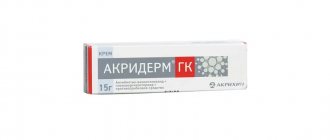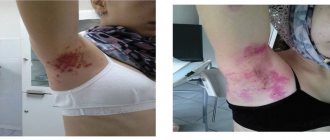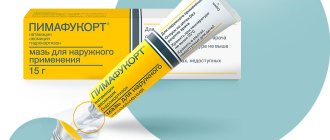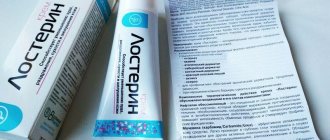An important role in the successful treatment of dermatoses is played by reducing the severity of external manifestations of the disease. These include:
- redness of the skin;
- rashes;
- skin itching;
- peeling;
- various inflammations.
The use of external preparations allows us to reduce them to a minimum. But it is not enough to act only on external signs. It is also necessary to combat the causes of their appearance, namely, fungal and bacterial infections. Treatment of skin diseases requires an integrated approach, and in this regard, one of the most preferred products is Akriderm GK cream. It has a unique combined composition, thanks to which it has 4 different effects on the skin problem, and also fights the causes of its occurrence. Let's take a closer look at what the drug "Akriderm GK" (cream) is used for and how to use it.
Pharmacodynamics and pharmacokinetics
The effect of this combination drug is due to its components, which are a glucocorticosteroid, an aminoglycoside antibiotic and an antifungal agent.
The use of betamethasone dipropionate helps to inhibit the concentration of leukocytes , the formation of lysosomal enzymes and a number of anti-inflammatory mediators in the area of inflammation. In this case, phagocytosis is inhibited, vascular-tissue permeability is reduced and the occurrence of inflammatory swelling is prevented.
Gentamicin, which is a broad-spectrum antibiotic Its action is directed against the causative agents of many primary and secondary bacterial infections of the skin, namely: gram-negative and gram-positive bacteria. However, anaerobes, fungi and viruses are not sensitive to this substance.
The antifungal effect of the drug is provided by clotrimazole. In this case, the synthesis of ergosterol, which makes up the cell membrane of fungi, is disrupted.
Activity is manifested against the most common fungi: Trichophyton rubrum, Epidermophyton floccosum, Candida albicans and so on.
Contraindications
It is not recommended to use Akriderm GK cream or ointment if:
- hypersensitivity to it;
- skin tuberculosis;
- cutaneous syphilis;
- skin post-vaccination reactions;
- chicken pox;
- herpes simplex;
- lactation;
- children under one year of age;
- otitis externa.
Side effects
The use of GCS often causes side effects such as burning, irritation, excessive dry skin, hypertrichosis, folliculitis, acne , hypopigmentation, dermatitis , and so on.
Long-term use, especially under occlusive dressings, can cause prickly heat, maceration or atrophy of the skin, secondary infection, and purpura.
Children should be treated with extreme caution to avoid the occurrence of systemic undesirable effects such as hyperglycemia, glucosuria , suppression of the adrenal cortex, Cushing's syndrome , etc.
Instructions for use Akriderm GK (Method and dosage)
Akriderm GK ointment instructions for use recommend applying it externally only. In this case, the product is applied in a fairly thin layer to the affected areas of the skin. This needs to be done 2 times every day.
It should be noted that the instructions for use for Akriderm GK cream contain the same therapeutic regimen. But it is also possible for a doctor to prescribe individual treatment, depending on the severity of the disease. Mild cases allow the use of the cream only once a day, and more severe cases, on the contrary, increase the frequency of use.
The duration of therapy usually depends on how effective this remedy was in a particular case, and can be 2-4 weeks.
In the absence of a positive result for a long time, it is necessary to clarify the diagnosis.
Directions for use and dosage
The instructions for the drug provide a standard dosage and application regimen. The drug is used externally; it must be applied carefully, lightly rubbing a small amount of the product into the affected areas of the skin. Apply 2 times a day, usually in the morning and evening. The duration of treatment is determined individually and depends on the nosological form and severity of the disease. For tinea pedis, the average duration of treatment is 2 to 4 weeks.
If clinical improvement does not occur in the near future, it is necessary to clarify the diagnosis or change the treatment regimen.
special instructions
The appearance of symptoms of sensitivity, skin irritation and other undesirable symptoms caused by the use of the drug requires abandoning this therapy and choosing another suitable remedy.
Long-term treatment, application of cream or ointment to large skin surfaces, use of occlusive dressings and therapy in children can cause systemic absorption of GCS.
This external remedy can be used in the treatment of children over one year of age, but only on the recommendation and under the close supervision of a specialist, which will avoid systemic side effects. It has been established that applying Akriderm GK cream or ointment over large areas for a long time leads to inhibition of the hypothalamic-pituitary-adrenal system, hypercortisolism, decreased excretion of hormone and increased intracranial pressure.
In addition, with prolonged application to the face, atrophic changes often occur, compared to other areas of the skin. For this reason, you should adhere to the standard therapeutic course, which is 5 days.
It is contraindicated to use any form of the drug in ophthalmology, avoiding accidental contact not only with the eyes, but also with mucous membranes.
Results and discussion
As a result of an open observational study, data were obtained on the high effectiveness of Akriderm GK
(betamethasone + gentamicin + clotrimazole) in the treatment of steroid-sensitive dermatoses complicated by bacterial and/or fungal infection.
The use of the drug Akriderm GK
(betamethasone + gentamicin + clotrimazole) was assessed at the end of the observation.
An excellent assessment of the effectiveness of the drug was established in 70 (97.2%) patients, good in 2 (2.8%), satisfactory and unsatisfactory were not recorded in any case. Clinical cure was established in 97.2% of patients, significant improvement in 2.8%. Not a single patient remained without effect from the therapy. Excellent tolerability of the drug was noted in 98.6% of patients, good - in 1.4% (mild itching was noted, which went away on its own after 3 days). There were no significant side effects requiring discontinuation of the drug in our study. When using Akriderm GK
(beta-methasone + gentamicin + clotrimazole), the DIQL of patients statistically significantly improved.
We present clinical cases.
The patient is 13 years old, diagnosed with atopic dermatitis, complicated by bacterial and fungal infection (Fig. 1, a). When contacted, the patient complained of weeping in the axillary folds and itchy skin. Local status: against the background of brightly colored inflammatory erythema, yellow crusts, infiltration, and weeping are visible. Budding (yeast) cells were found in the scraping. Based on the clinical picture (layering of yellow crusts), we can talk about the addition of a bacterial (streptococcal) infection. The patient received the following treatment: fucorcin 1-2 times a day for 5-7 days, 10-15 minutes after drying, apply Akriderm GK
2 times a day for 7 days. During treatment, a decrease in the brightness of manifestations and inflammatory phenomena was noted. After treatment, the pathological process was completely resolved (fucorcin residues are visible) (see Fig. 1, b). Since the patient is a teenager, bristly hair growth is visible in the axillary areas. After 14 days and 1 month from the start of treatment, the patient was examined. The pathological process was in remission.
Rice.
1. Atopic dermatitis, complicated by bacterial and fungal infection, in a 13-year-old patient. a - before treatment; b - after treatment. The patient is 23 years old, diagnosed with microbial (coin-shaped) eczema: abortive form (eczematid) (Fig. 2, a). Differential diagnosis was made with mycosis of smooth skin. The pathological foci were erythematous-squamous, large in size, round, with clear boundaries, in the center there were areas of resolution with peeling. No threads of septate mycelium were found in the scraping. The following treatment was prescribed: Akriderm GK
2 times a day for 14 days. During treatment, the pathological lesions resolved completely (see Fig. 2, b), only light temporary pigmentation remained visible. The patient did not show up for further examination.
Rice.
2. Foci of numular eczema. a - before treatment, b - their regression after 14 days of therapy. The patient is 63 years old, diagnosed with atopic dermatitis, complicated by a fungal infection (Fig. 3, a, 4, a). The patient suffered from atopic dermatitis as a child. I did not notice any exacerbations with age. Complained of dry skin. On examination, dry skin and pronounced skin patterns in the elbow and popliteal folds were noted. When contacted, he complained of dry skin in the area of the palms, rashes in the area of the inguinal folds, accompanied by itching. In the area of the palms, powdery small folds and cracks were revealed; in the area of the inguinal folds there is a spot of hyperemia with clear sharp boundaries in the form of a roller consisting of crusts, scales, and erosions. Threads of septate mycelium were found in scrapings from the palms and inguinal folds. The following treatment was prescribed: Akriderm GK
2 times a day for 14 days on the groin area,
Akriderm GK
2 times a day for 14 days on the palms. After 14 days, the pathological process in the area of the palms and inguinal folds was completely resolved (see Fig. 3, b, 4, b). No threads of septate mycelium were found in scrapings from the palms and inguinal folds. The patient was examined 1 month after the start of therapy. The pathological process was in remission.
Rice. 3. Rashes due to atopic dermatitis on the hands of a 63-year-old patient. Fungal contamination has been proven. a — before treatment, b — after treatment.
Rice.
Fig. 4. Erythematous-squamous lesions in the area of the inguinal-femoral fold (a) and their regression in the same patient after therapy (b). The patient is 25 years old, diagnosed with allergic contact dermatitis, complicated by a bacterial infection (Fig. 5, a). On the skin around the mouth, against the background of bright hyperemia, yellow crusts and weeping are visible. The patient was prescribed the following treatment: sodium thiosulfate 30%, 10 ml intravenously for 10 days; Levocyterizine 10 mg orally 1 time per day (10 days); topical cream Akriderm GK
2 times a day (7 days). After 7 days, the pathological process was completely resolved: the rash around the mouth disappeared (see Fig. 5, b). The prescription of combination drugs containing topical corticosteroids and antibiotics for bacterial infections quite often provokes the growth of saprophytic candidiasis microflora, which worsens the course of the underlying disease. Therefore, the most effective combination therapy is drugs that contain corticosteroids, antibacterial and antimycotic agents, which makes it possible to simultaneously influence all parts of the pathological process [13].
Rice.
5. Manifestations of allergic contact dermatitis with impetiginization in a 25-year-old patient. a - before treatment; b - after treatment. Patient, 46 years old, diagnosed with chronic eczema of the hands, complicated by a secondary infection (fungal). The patient has been suffering from chronic eczema of the hands since the age of 20. It is also known from the medical history that the patient works as a driver. Hands often come into contact with lubricants. Periodically over the course of 26 years, exacerbations occur, which are replaced by remissions. The latest exacerbation is associated with nervous shock. At the time of treatment, the pathological process is represented by foci of mild hyperemia, there are yellow crusts, scales, scratches, small pink papular elements, cracks (Fig. 6, a, b). Noteworthy is the absence of supracungual skin (a sign of a candidiasis infection). Yeast-like cells were found in scrapings from the periungual ridges. The following treatment was prescribed: Akriderm GK
2 times a day for 14 days.
When examined after 14 days, the pathological process resolved: hyperemia disappeared, dry skin, peeling, and isolated crusts remained. Akriderm
ointment was prescribed 2 times a day (10 days). When examined after 10 days, the pathological process resolved completely (see Fig. 6, c, d). After 1 month from the start of therapy, the patient was examined. The pathological process was in remission.
Rice.
6. Chronic eczema of the hands, complicated by mycotic infection in a 46-year-old patient. a, b — skin status before treatment; c — after two weeks of external treatment with a three-component drug; d - after additional use of phonophoresis with the ointment used. The average for the group at the time of the first visit was 14 points (8; 18); 14 days after the start of therapy - 1 point (1; 5) ( p
<0.05);
1 month after the start of therapy - 1 point (1; 3) ( p
<0.05). At the time of the first visit, the high DIQL is explained by the fact that any manifestations of dermatoses lead to psycho-emotional problems in the patient. Moreover, even minor rashes are accompanied by high DIQL values, since they are located on an open area of the skin and are visible to others.
Analogues of Akriderm GK
Level 4 ATX code matches:
Rederm
Losterine
Akriderm SK
Akriderm
Akriderm Genta
Elokom S
Diprosalik
Belosalik
Triderm
Kanizon Plus
Betasalik
Triacutan
Momat-S
The main analogues are represented by the following drugs: Triderm and Kanison.
At the same time, the price of analogues varies between 470-720 rubles.
Reviews about Akriderm GK
According to many users, this external remedy is one of the most effective. Although reviews of Akriderm GK cream are more common than ointment reviews. In any case, each form of this drug is prescribed to treat a variety of skin diseases and usually patients notice improvement within a couple of days.
It should be noted that in addition to positive reviews, you can also find reports of side effects. Symptoms that indicate intolerance or sensitivity to this drug are usually described: increased redness, peeling, development of inflammation, and so on.
In addition, patients often report that the drug helps only while you use it, and soon after discontinuation, the symptoms of the disease return again.
The reason for this is, most likely, that Akriderm GK helps suppress the manifestations of the disease, but still does not affect the disease itself. Therefore, in addition to the drug that alleviates the patient’s condition, the main treatment of the source of the health disorder must also be carried out.
In any case, it is not recommended to use this remedy without the prescription of a specialist. In addition to the fact that therapy may simply be useless, it is possible that severe complications may arise, which usually require long-term treatment.
Benefits of Akriderm GK cream
First of all, it is worth noting the affordable price of the drug. "Akriderm GK" is available in packages of 15 g and 30 g. The price of a 30 g tube is more favorable for the buyer compared to 15 g of another product against skin problems. The drug also has over-the-counter status and is available to a wide range of consumers.
But the main advantage of Akriderm GK lies in its versatile action. It deals a powerful blow to the source of inflammation, affecting not only the external manifestations of the disease, but also its causes. Many patients have reported a significant reduction in itching, redness and swelling after application.
Akriderm GK price, where to buy
The price of Akriderm GK cream is 130-400 rubles.
The price of Akriderm GK ointment is 350-650 rubles.
- Online pharmacies in RussiaRussia
- Online pharmacies in KazakhstanKazakhstan
ZdravCity
- Akriderm GK ointment d/nar.
approx. 0.05%+0.1%+1% 15gAO Akrikhin RUB 486 order - Akriderm GK cream 30gAO Akrikhin
RUR 782 order
- Akriderm GK cream 15gAO Akrikhin
RUB 482 order
Pharmacy Dialogue
- Akriderm GK ointment (tube 15g) Akrikhin OJSC
RUR 513 order
- Akriderm GK cream (tube 15g) Akrikhin OJSC
RUB 505 order
- Akriderm GK cream 30g Akrikhin OJSC
RUR 773 order
- Akriderm GK ointment (tube 30g) Akrikhin OJSC
RUR 765 order
show more
Material and methods
We observed 72 patients from 18 to 60 years old with steroid-sensitive dermatoses, of which 15 patients had chronic eczema of the hands, complicated by secondary infection; with microbial eczema - 14; with atopic dermatitis complicated by secondary infection - 15; with allergic contact dermatitis complicated by secondary infection - 28 patients. Patients applied to the diagnostic and treatment center of the clinics of the Siberian State Medical University for an outpatient appointment.
The treatment regimen was as follows: Akriderm GK
Apply a thin layer to the affected areas of sensitive skin 2 times a day.
The duration of treatment ranged from 7 to 14 days. Akriderm GK
ointment was applied in a thin layer to the affected areas of the body with pronounced peeling 2 times a day. The duration of treatment ranged from 7 to 14 days. The average duration of observation per patient was 1 month, during which there were three visits.
The selection of patients was carried out in accordance with the inclusion and exclusion criteria. The study included patients meeting the following criteria: men and women aged 18 to 60 years with steroid-sensitive dermatoses complicated by secondary infection. The study did not include patients with at least one of the following criteria: pregnancy less than 12 weeks; hypersensitivity to the drug or its components; the use of systemic and external corticosteroids, antibiotics, antifungal drugs. The study did not include patients with diseases and conditions indicated as contraindications to the use of the drug: skin tuberculosis, viral infections, perioral dermatitis, rosacea, vaccination.
Clinical effectiveness was assessed based on the reduction in activity and extent of the process. The study used a score for the symptoms of the disease: 0 points - no signs; 1 point - mild severity; 2 points - moderate severity and 3 points - strong severity.
The effectiveness of treatment was assessed according to the following criteria: clinical cure, significant improvement, improvement, no effect.
The timing of treatment results was noted on the 1st, 14th and 30th day from the start of therapy.
Before and during treatment of patients, the quality of life of patients was studied using a questionnaire. The transformation of the quality of life involved the respondent’s self-assessment of his physical, mental, social and economic well-being using a questionnaire using the dermatological quality of life index (DQL). The questionnaire made it possible to express in points the patient’s assessment of his physical condition, mood and general quality of life during the 1 week preceding the questionnaire, as well as to establish the reason for the decrease in quality of life and present the results in the form of a single number. The maximum score could be 30 points.
To analyze safety and tolerability indicators, we took into account adverse events (their characteristics and frequency), assessed on a 4-point categorical scale: excellent - no side effects; good - mild side effects that do not require medical intervention; satisfactory - moderate side effects; bad - severe side effects requiring discontinuation of the drug.
Comorbidity was not a criterion for excluding a patient from the sample population, and treatment of concomitant diseases was carried out according to the usual regimen, and the drugs used in their treatment could be used simultaneously with the drug Akriderm GK
(betamethasone + gentamicin + clotrimazole).
Statistical processing of the results was carried out using the SPSS 17.0 for Windows application package. The critical level of significance when testing statistical hypotheses in this study was taken to be p
=0.05 (achieved significance level). The distribution of quantitative data was checked using the Shapiro-Wilk test. The results of the study were summarized using the χ2 criterion.




